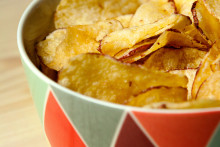Do you want to reduce your intake of sodium, but want your evening snack to taste nice and salty? Forget seasoning, get a bowl with the right surface texture. This might just work – at least according to the study by Van Rompay and Groothedde from the UT’s Department of Communication Science. Their paper ‘The taste of touch: Enhancing saltiness impressions through surface texture design’ was published last month in the journal Food Quality and Preference.
Potato chips
To see if the perceived saltiness of a product can be influenced by design, the researchers conducted an experimental study using potato chips. ‘We used three types of chips: no salt, medium salt and high salt,’ Van Rompay explains. ‘We served those in two different cups – one with a smooth texture and one with an irregular, rough texture.’
It seems that the rough cup ‘does the trick’. ‘Our findings show that the rough texture makes the medium salt and high salt chips taste saltier and more intense, it enhances the saltiness perception and the taste intensity,’ says Van Rompay. ‘However, for the no salt variant the effect was reversed. It makes the no salt chips taste even less salty. This is probably because you expect a salty snack but it’s not salty at all, so the contrast is too big.’
The research also found that people are more willing to try samples from the cups with irregular rough texture. ‘But we didn’t find any effect of the texture on the taste liking,’ clarifies the UT researcher. ‘It only showed that we can increase the intensity and salt perception, not how much people enjoy it.’
Ramen noodles
Together with his colleague Daniel Saakes from KAIST (Korea Advanced Institute of Science and Technology), Van Rompay now aims to begin a more systematic research into saltiness perception. To start with, they plan to conduct experiments with ramen noodles and different types of serving bowls.
‘Once we have a better insight into how to influence the taste, we will look at how to best apply the findings in real life,’ says Van Rompay, who aims to use the research to promote healthy eating. ‘It could be useful for people who need special diets and can’t eat any salt. For example, it could be applied in hospitals to make low-salt meals a bit tastier.’







